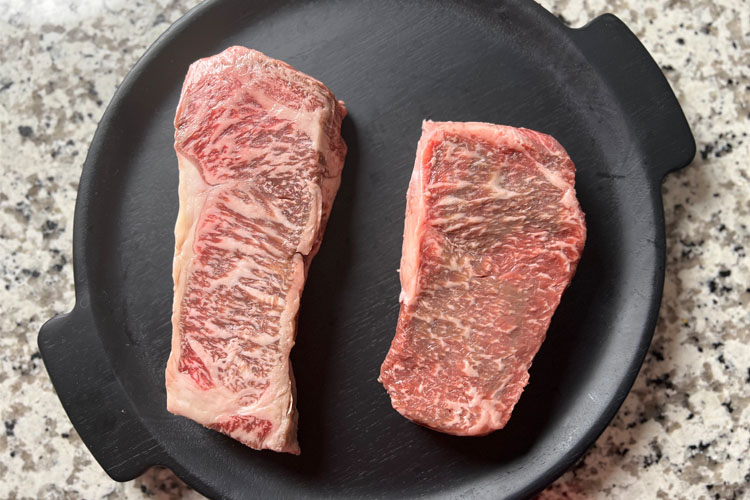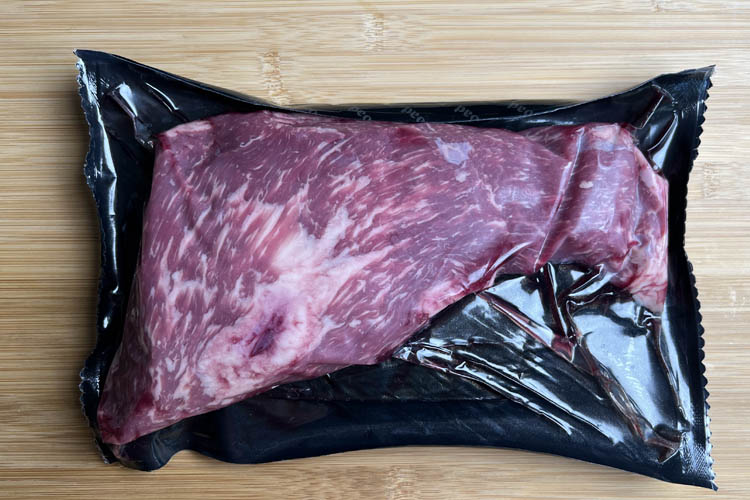For the optimal cooking experience, you don’t want to pick up the first steak you come across at the grocery store.
Let these tips on what to look for when buying steak guide you toward the best option. Keep reading to also discover our top steak recommendations and where to buy them.
The 5 things to look for when buying steak
This is what we like to call our steak-buying criteria. Focus on these five characteristics to choose the best steak for your grill.
1. Grade
The USDA grading system is a quick and easy way to identify a steak’s quality. The USDA grades beef cuts into one of three categories based on the degree of marbling and the carcass’s age:
- Prime—Less than 2% of all US beef is Prime-graded. USDA Prime certification indicates the highest-quality meat with between 8 and 13 percent intramuscular fat.
- Choice—Once only available through butchers, the number of supermarkets now stocking USDA Choice-graded beef has significantly increased. The Choice grading indicates good quality but a lower level of marbling, around 4 to 10 percent.
- Select—Select beef is the most common beef grade found in supermarkets and contains very little marbling, just 2 to 4 percent. Select steak also comes from younger cattle (under 30 months), so it typically lacks some of the flavors you’d find in a USDA Choice or Prime cut.
2. Marbling
As mentioned, marbling is one of the critical criteria for how the USDA grades beef. It refers to the degree of intramuscular white fat flecks in each beef steak.
The more marbling, the more tender, juicy, and flavorful the beef is. Extra marbling also protects the beef while cooking and prevents it from drying out as it melts down, moisturizing the meat.
So when buying steak, remember a well-marbled steak has many white fat flecks and stripes. Avoid any meat with large clumps of fat down the center, as this gets greasy and causes flare-ups. You want thin flecks, not fat chunks.
3. Thickness
We have a complete guide to steak thickness. Ideal thickness depends on factors like personal preference and whether it’s a naturally thin steak cut like a flank steak.
Generally speaking, we think the thicker, the better, and recommend aiming for a steak around 1.5 inches thick. This is the perfect number for us because the steak remains quick to cook without being too easy to overcook.
If buying pre-packaged steak, ensure each steak has the same thickness to make cooking easier.
4. Color
A great steak cut is deep pink or light cherry red with those white fat flecks across the center. A brown or grey hue indicates the steak has had too much oxygen exposure and might be older.
You also only want a steak with white marbling. If the fat has a brown or yellow tint, this suggests the meat is either dry or old.
5. Packaging
There are a few elements to inspect when picking up a pre-packaged steak from the grocery store. It’s time to use the senses of touch, smell, and sight.
First, check out the amount of moisture inside. An extra wet steak sitting in liquid indicates it might have been frozen and then thawed. We want the freshest option, so have a look and see if there’s a dryer-looking piece.
Next, ensure the meat is firm and cold to the touch and the packaging has no visible cuts or tears. Then, sniff it, as fresh meat won’t have an odor.
Finally, of course, you don’t want to leave the store without double-checking the sell-by or use-by date.
Here are some other ways to tell if a steak is spoiled.
What else to look for when buying steak
I’ve covered the main factors to look at when buying steak, but there are a couple of more terms and specifications that are helpful to know.
Wagyu vs. Kobe beef
Wagyu beef is exclusively from the Kuroge Washu (or Japanese Black) cattle breed. It has exceptional marbling and a global reputation for melt-in-the-mouth tenderness and a rich umami flavor.
Imported Japanese Wagyu beef is both expensive and rare, selling for $50 per ounce at the top end of the price range. American Wagyu beef is available, although it’s most commonly from cattle interbred with native strains, such as Angus beef.
The USDA certifies some beef as Wagyu, but it must only contain 46.875% pure Japanese blood to obtain certification.

Japanese Wagyu and American Wagyu steaks
There’s much confusion about the difference between Kobe and Wagyu, as the terms are often used interchangeably. Kobe beef is ultra high-quality Japanese trademarked beef from the Hyogo prefecture that costs around $300 per pound and is sold at just 33 US restaurants.
We recommend avoiding anything marketed as “Kobe-style” beef as it indicates nothing about the product’s quality or origin.
Dry vs. wet aging
Nearly all commercially available beef undergoes aging. It’s a form of carefully controlled decomposition that increases the flavor and tenderness of the meat while removing the metallic taste left behind when freshly slaughtered.
Wet aging is the more common method. It’s called wet aging because the beef is stored in a vacuum-sealed bag with its own liquids. Wet-aged beef doesn’t lose any weight due to moisture loss but can sometimes have a slight mineral taste.
Dry aging involves hanging beef cuts in a temperature and humidity-controlled environment for several months. During this time, bacterial activity, enzyme breakdown, and oxidation tenderize the meat and increase its flavor.

Dry aged tri-tip steak from Porter Road
Dry-aged beef is typically more expensive than wet-aged because it results in moisture loss, shrinking the meat and leaving less to sell, making it proportionally more expensive by weight. Unlike wet aging, which only tenderizes the meat, dry aging both tenderizes and increases the flavor, making the end product more desirable as well.
If you have space and are willing to invest in a few tools, you can dry-age your own beef at home.
Grass-fed vs. grain-fed
We have a whole article covering the difference between grain and grass-fed beef.
The main differences are that grass-fed beef is better for the environment, may be raised more humanely (depending on the supplier), and is typically more expensive because it takes the cow longer to reach slaughter weight.
Then there’s the difference in taste. Grass-fed beef has a distinctive taste that some people prefer to grain-finished meat’s richer, more buttery flavor. It’s leaner with a chewier texture and less marbling. Meanwhile, grain-fed beef is prized for its fat, consistency, and smooth texture.
There’s no “better” option with any of these characteristics. It’s down to your personal taste (and budget, more often than not).
What is the best cut of steak to buy?
The answer depends on several factors, but here are our recommendations for the best steaks to grill with recipes. Our top 10 includes classics like ribeye steak, filet mignon, porterhouse steak, and underrated cuts like flank steak.
Where to buy steak
The next step in our steak-buying guide is to go shopping. We like to shop for steak at three main places.
Butcher
If you love steak and have a local butcher shop, it’s time to become well acquainted with the staff behind the counter. They can give you insider tips and recommendations and prepare your steaks your preferred way.
Grocery store
This post on brisket prices highlights why you shouldn’t skip over your grocery store when buying steak. You can find high-quality steak in stores like Walmart, H-E-B, and Costco. You just won’t find personalized service like at a butcher.
Let the USDA grading system guide you toward the best steak at your local store.
Online
Buying steak from the internet might seem unconventional. But plenty of reputable professional butchers online can deliver specialist steaks to your door in as little as 24 hours.
We have an entire guide to the best online steak delivery companies. But our favorite websites for buying top-quality steak include:
- Snake River Farms—Our favorite suppliers of domestic American Wagyu
- Porter Road—A great option for variety, quality, and service.
- Crowd Cow—Perfect if you want to know where your meat comes from and how it’s raised.
- Holy Grail Steak Company—An impressive collection of authentic imported Wagyu and Kobe beef.
Continue your steak education
Now that you know what to look for when buying steak, what steak to buy, and where to buy it, here are some extra helpful posts to guide you through the next steps.
Did you miss our previous article...
https://manstuffnews.com/backyard-grilling/the-best-smoked-buffalo-chicken-dip
 Backyard GrillingWeekend WarriorsAdvice from DadBeard GroomingTV Shows for Guys4x4 Off-Road CarsMens FashionSports NewsAncient Archeology World NewsPrivacy PolicyTerms And Conditions
Backyard GrillingWeekend WarriorsAdvice from DadBeard GroomingTV Shows for Guys4x4 Off-Road CarsMens FashionSports NewsAncient Archeology World NewsPrivacy PolicyTerms And Conditions
